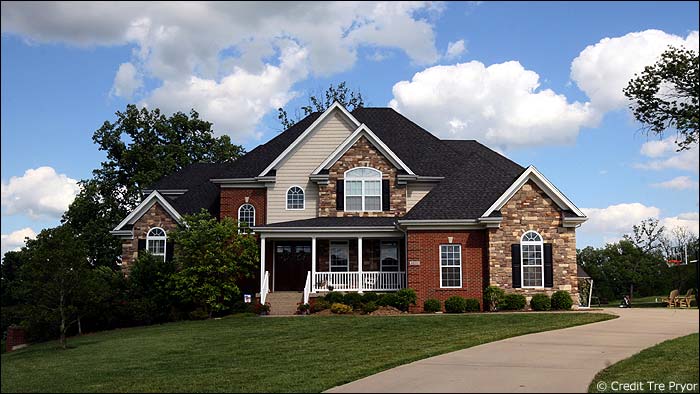Your roof is one of the most critical components of your home. It protects you from harsh weather, adds structural integrity, and enhances curb appeal. But, like everything else, it has a lifespan. Over time, shingles wear out, leaks develop, and structural damage becomes a real concern. Ignoring these issues can compromise your home’s safety. Let’s walk through the step-by-step guide to replacing your roof.

A Step-by-Step Guide to Replacing Your Roof
Replacing a roof is a significant investment, so it’s essential to approach the process with the right knowledge. From inspection to material selection and proper installation, each step plays a crucial role in ensuring your new roof lasts for decades.
So, here’s everything you need to know about replacing your home’s roof the right way.
1. Get a Professional Roof Inspection First
The first step in our guide to replacing your roof is the inspection. Before you start tearing off shingles or calling contractors for estimates, the first and most important step is a professional roof inspection. Many homeowners assume they need a full roof replacement when, in reality, some targeted repairs could extend the roof’s lifespan. An inspection provides a clear assessment of your roof’s condition and prevents unnecessary expenses.
A trained roofing professional will look for signs of wear and damage that the untrained eye might miss. They check for missing or curling shingles, water damage, mold growth, sagging areas, and compromised flashing. Catching these problems early can help prevent more extensive structural issues down the line.
Finding the right inspector is just as important as the roof inspection itself. A top-tier roofing company will not only diagnose the problem accurately but also provide honest recommendations.
2. Understand the Costs Involved
As mentioned earlier, a roof replacement is a big investment, and understanding the costs beforehand helps you plan your budget wisely. Several factors influence the total price, including roof size, slope, material choice, labor, and any structural repairs needed. On average, homeowners spend thousands of dollars on a new roof, but the exact amount varies depending on location and material selection.
Requesting detailed estimates from multiple contractors is crucial. Be cautious of bids that seem too low, as they often signal the use of inferior materials or unqualified laborers. At the same time, the highest bid does not necessarily mean the best quality.
In some cases, homeowner’s insurance may cover part of the replacement cost, especially if the damage was caused by storms or other natural events. Review your policy and speak with your insurance provider to determine eligibility.
3. Choose the Right Roofing Material for Your Home
Selecting the right roofing material is just as important as hiring the right contractor. Different materials come with different benefits, lifespans, and price points. Asphalt shingles are the most common due to their affordability and ease of installation, but they typically last only 20 to 30 years. Metal roofing is more expensive but offers superior durability and energy efficiency. Slate and tile are premium choices known for their longevity and aesthetic appeal, but they require a strong roof structure due to their weight.
Consider your city’s climate when comparing roofing materials. If you live in an area prone to extreme weather, impact-resistant shingles or metal roofing might be a better choice. Energy-efficient options like cool roofing materials can also help reduce energy bills by reflecting more sunlight and absorbing less heat.
Beyond functionality, the material should also complement your home’s design. A mismatched roof can diminish curb appeal and lower property value. It’s worth consulting with a roofing expert to find the best balance between aesthetics, durability, and cost.
4. Get the Necessary Permits and Paperwork
Many local governments require homeowners to secure a permit before starting a roofing project. These permits ensure the work complies with building codes and safety regulations.
Most professional roofing contractors handle the permitting process on behalf of homeowners. However, it’s still your responsibility to confirm that all paperwork is in order before work begins. If your home is in a neighborhood governed by a homeowner’s association (HOA), additional approvals may be required. Always check these regulations early in the process to avoid delays.
5. Prepare Your Home and Yard for the Installation
A roof replacement is a noisy, messy project that requires proper preparation to minimize disruptions. Before work begins, clear the driveway to make room for contractor vehicles and material deliveries. Move outdoor furniture, grills, and potted plants away from the work area to prevent accidental damage. Cover flower beds and shrubs with tarps to shield them from falling debris.
Inside your home, remove fragile items from walls and shelves. The vibrations from hammering and heavy equipment can cause pictures and decorative pieces to fall. If you have pets or young children, consider arranging for them to stay elsewhere during the noisiest parts of the project.
Informing your neighbors in advance is also a courteous step. Since roofing projects generate noise and dust, giving them a heads-up allows them to plan accordingly.
6. Inspect and Repair the Roof Decking
Once the old roofing materials are removed, the underlying structure—the roof decking—is exposed. This wooden foundation must be in good condition before any new roofing material is installed. If the decking has rot, mold, or soft spots, these areas must be repaired or replaced. Failing to address these issues can lead to long-term structural problems, including sagging or leaks.
A roofing professional will check for signs of water damage, gaps, and weak areas. If the decking is compromised, replacing it with fresh, durable plywood or oriented strand board (OSB) is necessary to provide a solid foundation. Some contractors also add a layer of water-resistant underlayment to further protect the decking from moisture.
7. Install the New Roofing System Correctly
With the roof deck prepared, it’s time to install the new roofing system. The process begins with a protective underlayment, which acts as a moisture barrier between the shingles and the decking.
Next, flashing is installed around areas vulnerable to water infiltration, such as chimneys, vents, and skylights. Flashing is typically made of metal and helps direct water away from these openings.
Once the protective layers are in place, the chosen roofing material is carefully installed. Roofers follow a specific pattern, ensuring each piece overlaps correctly to create a watertight seal. Incorrect installation can lead to early wear, leaks, and energy inefficiency.
Replacing a roof is a detailed process that requires careful planning and skilled installation. Once installed, a new roof should be cared for with routine inspections and maintenance. Investing in proper upkeep will extend its lifespan and prevent costly repairs in the future. By following these steps and working with trusted professionals, you can ensure your home’s roof remains strong, secure, and efficient for years to come.
We hope our step-by-step guide to replacing your roof has been valuable to you. Check back often for new home improvement content.


